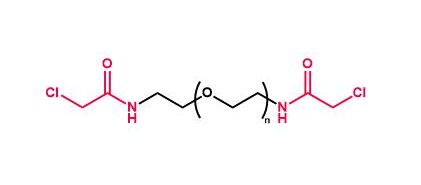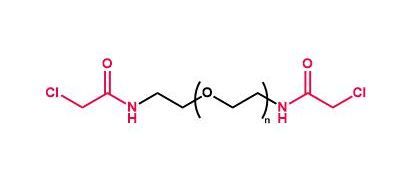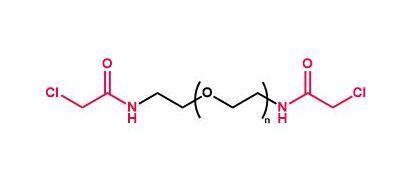ReadiUse CL-APC [交联 – 别藻蓝蛋白] *无硫酸铵*
![ReadiUse CL-APC [交联 - 别藻蓝蛋白] *无硫酸铵* 货号2503](http://www.jinpanbio.com.cn/wp-content/uploads/2022/09/20220924_632f8593808b8.jpg) |
货号 |
2503 |
存储条件 |
在2-8度冷藏保存, 避免光照 |
| 规格 |
1 mg |
价格 |
1272 |
| Ex (nm) |
651 |
Em (nm) |
660 |
| 分子量 |
~105000 |
溶剂 |
Water |
| 产品详细介绍 |
简要概述
产品基本信息
货号:2503
产品名称:ReadiUse CL-APC [交联 – 别藻蓝蛋白] *无硫酸铵*
规格:1mg
储存条件:2-8℃避光防潮
保质期:12个月
产品物理化学光谱特性
分子量:N/A
溶剂:水
激发波长(nm):651
发射波长(nm):662
产品介绍
ReadiUse CL-APC [交联 – 别藻蓝蛋白]是美国AAT Bioquest生产的蛋白标记染料,交联的别藻蓝蛋白(CL-APC)是从螺旋藻(一种蓝绿藻)中分离的藻胆蛋白。与其他藻胆蛋白一样,APC具有强荧光性,具有极高的吸收率和高量子效率。它是一种蛋白质,通过常规蛋白质交联技术可以很容易地与抗体和其他蛋白质连接,而不会改变其光谱特征。 APC在主要的藻胆蛋白中是最不稳定的,在低浓度下易于解离,包括进行某些测定的浓度。 CL-APC在α和β亚基之间发生化学交联,比APC稳定得多。交联的APC在水溶液中具有改善的稳定性。然而,所有商业APC材料都在浓硫酸铵缓冲液中出售。来自其他供应商的商业APC材料需要进行繁琐的透析或其他纯化,然后才能用于标记目的。 AAT Bioquest提供此ReadiUse APC,可轻松用于任何标签,无需任何纯化。我们高度纯化的ReadiUse APC促进APC与抗体和其他蛋白质(如链霉抗生物素蛋白和其他二级试剂)的快速结合。金畔生物是AAT Bioquest的中国代理商,为您提供最优质的ReadiUse CL-APC [交联 – 别藻蓝蛋白]。
点击查看光谱
参考文献
Chromophore attachment to phycobiliprotein beta-subunits: phycocyanobilin:cysteine-beta84 phycobiliprotein lyase activity of CpeS-like protein from Anabaena Sp. PCC7120
Authors: Zhao KH, Su P, Li J, Tu JM, Zhou M, Bubenzer C, Scheer H.
Journal: J Biol Chem (2006): 8573
Excitation energy transfer from phycobiliprotein to chlorophyll d in intact cells of Acaryochloris marina studied by time- and wavelength-resolved fluorescence spectroscopy
Authors: Petrasek Z, Schmitt FJ, Theiss C, Huyer J, Chen M, Larkum A, Eichler HJ, Kemnitz K, Eckert HJ.
Journal: Photochem Photobiol Sci (2005): 1016
Single-molecule spectroscopy selectively probes donor and acceptor chromophores in the phycobiliprotein allophycocyanin
Authors: Loos D, Cotlet M, De Schryver F, Habuchi S, Hofkens J.
Journal: Biophys J (2004): 2598
Evaluation of Tolypothrix germplasm for phycobiliprotein content
Authors: Prasanna R, Prasanna BM, Mohammadi SA, Singh PK.
Journal: Folia Microbiol (Praha) (2003): 59
Isolation and characterisation of phycobiliprotein rich mutant of cyanobacterium Synechocystis sp
Authors: Prasanna R, Dhar DW, Dominic TK, Tiwari ON, Singh PK.
Journal: Acta Biol Hung (2003): 113
Co-ordinated expression of phycobiliprotein operons in the chromatically adapting cyanobacterium Calothrix PCC 7601: a role for RcaD and RcaG
Authors: Noubir S, Luque I, Ochoa de Alda JA, Perewoska I, Tandeau de Marsac N, Cobley JG, Houmard J.
Journal: Mol Microbiol (2002): 749
Phycobiliprotein genes of the marine photosynthetic prokaryote Prochlorococcus: evidence for rapid evolution of genetic heterogeneity
Authors: Ting CS, Rocap G, King J, Chisholm SW.
Journal: Microbiology (2001): 3171
Novel activity of a phycobiliprotein lyase: both the attachment of phycocyanobilin and the isomerization to phycoviolobilin are catalyzed by the proteins PecE and PecF encoded by the phycoerythrocyanin operon
Authors: Zhao KH, Deng MG, Zheng M, Zhou M, Parbel A, Storf M, Meyer M, Strohmann B, Scheer H.
Journal: FEBS Lett (2000): 9
Phycobiliprotein-Fab conjugates as probes for single particle fluorescence imaging
Authors: Triantafilou K, Triantafilou M, Wilson KM.
Journal: Cytometry (2000): 226
[Phycobiliprotein and fluorescence immunological assay]
Authors: Wu P.
Journal: Sheng Li Ke Xue Jin Zhan (2000): 82
说明书
ReadiUse CL-APC [交联 – 别藻蓝蛋白] *无硫酸铵*.pdf


![ReadiUse CL-APC [交联 - 别藻蓝蛋白] *无硫酸铵* 货号2503](http://www.jinpanbio.com.cn/wp-content/uploads/2022/09/20220924_632f8593808b8.jpg)

